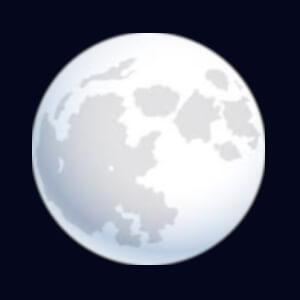



The Moon is the Earth's only natural satellite, or orbiting body. Most astronomers believe that the Moon was formed about 4.51 billion years ago—about 30 million years after the Earth—as the result of a massive impact between the Earth and a planet-sized asteroid, known as "Theia."
| The Moon | Earth | |
|---|---|---|
| Mass | 7.300 × 1022 kg | 5.972 × 1024 kg |
| Volume | 21,970,000,000 km3 | 1,083,000,000,000 km3 |
| Average Orbital Speed | 3,679 kph | 107,200 kph |
One of the most captivating aspects of the Moon is its ever-changing appearance. From Earth, we observe different phases of the Moon as sunlight illuminates its surface at different angles. These phases, including the full moon, crescent moon, and new moon, are the result of the positions of the Moon, Earth, and the Sun. The lunar cycle, which spans about 29.5 days on Earth, captures the complete sequence of these phases.
As the next-closest object to Earth in the solar system, the Moon has long been the target of human exploration and scientific study. In the late 1960s and early 1970s, during the Apollo program, NASA successfully sent several manned missions to the Moon. Astronauts from the Apollo missions collected lunar samples, conducted experiments, and provided valuable insights into the Moon's geology and history. These missions significantly expanded our understanding of the Moon and its relationship with Earth.
Because the Moon itself rotates as it orbits Earth, only 60% of its surface is ever visible from the Earth. That is why there is a dark side of the moon. In fact, however, the far side of the moon is illuminated by the Sun just as much as the near side!
As of 2019, more than 200 moons have been discovered (Jupiter has 67 known moons and Saturn 62).
The tallest is Mons Huygens, which, at about 4,700 m tall, is about half the height of Mt. Everest (8,848 m).
It takes about 1.255 seconds for moonlight to reach Earth. That means that when we look at the moon, we're really seeing what the moon looked like over a second ago!